Hypovolemia Shock: A Case Study of Maureen Hardy, Aged 77
VerifiedAdded on 2020/07/23
|8
|2789
|557
Case Study
AI Summary
This case study examines a 77-year-old woman, Maureen Hardy, who presented with haematemesis and was diagnosed with hypovolemic shock. The essay details the pathophysiology of hypovolemia, emphasizing the loss of blood volume and its impact on the body. It outlines the common signs and symptoms, including pale skin, increased heart rate, and altered mental status. The case study applies the ABCDE approach (Airway, Breathing, Circulation, Disability, Exposure) for patient assessment, detailing findings such as a high respiratory rate, low blood pressure, and altered consciousness. It also includes an ISBAR (Introduction, Situation, Background, Assessment, Recommendation) report to facilitate effective communication. The case study highlights the importance of immediate treatment, including oxygen therapy, addressing internal bleeding, and correcting anaemia. The analysis underscores the crucial role of nurses in patient assessment and the use of standardized communication tools like ISBAR in providing quality patient care. Finally, the case study emphasizes the need for prompt intervention to prevent complications such as heart stroke and severe shock.
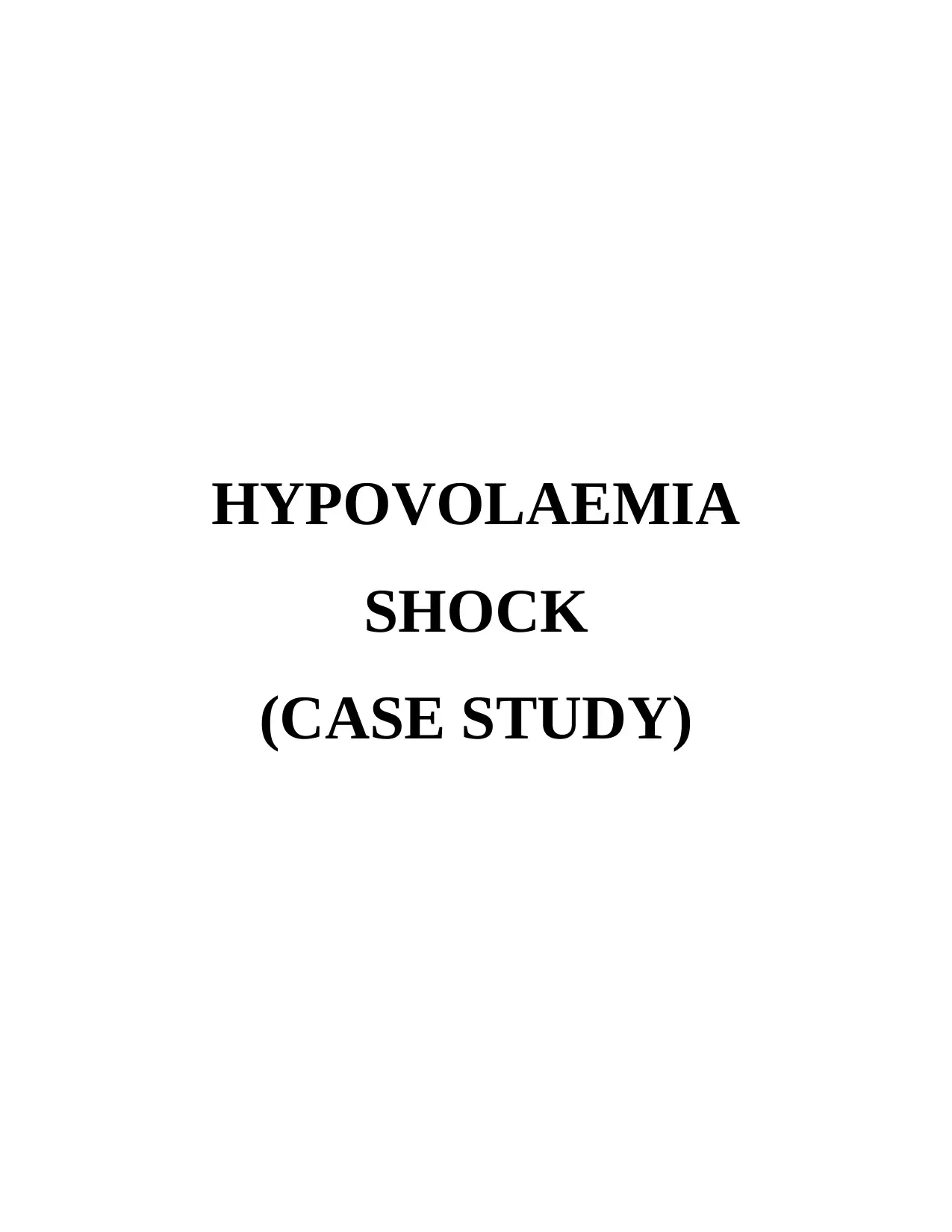
HYPOVOLAEMIA
SHOCK
(CASE STUDY)
SHOCK
(CASE STUDY)
Paraphrase This Document
Need a fresh take? Get an instant paraphrase of this document with our AI Paraphraser
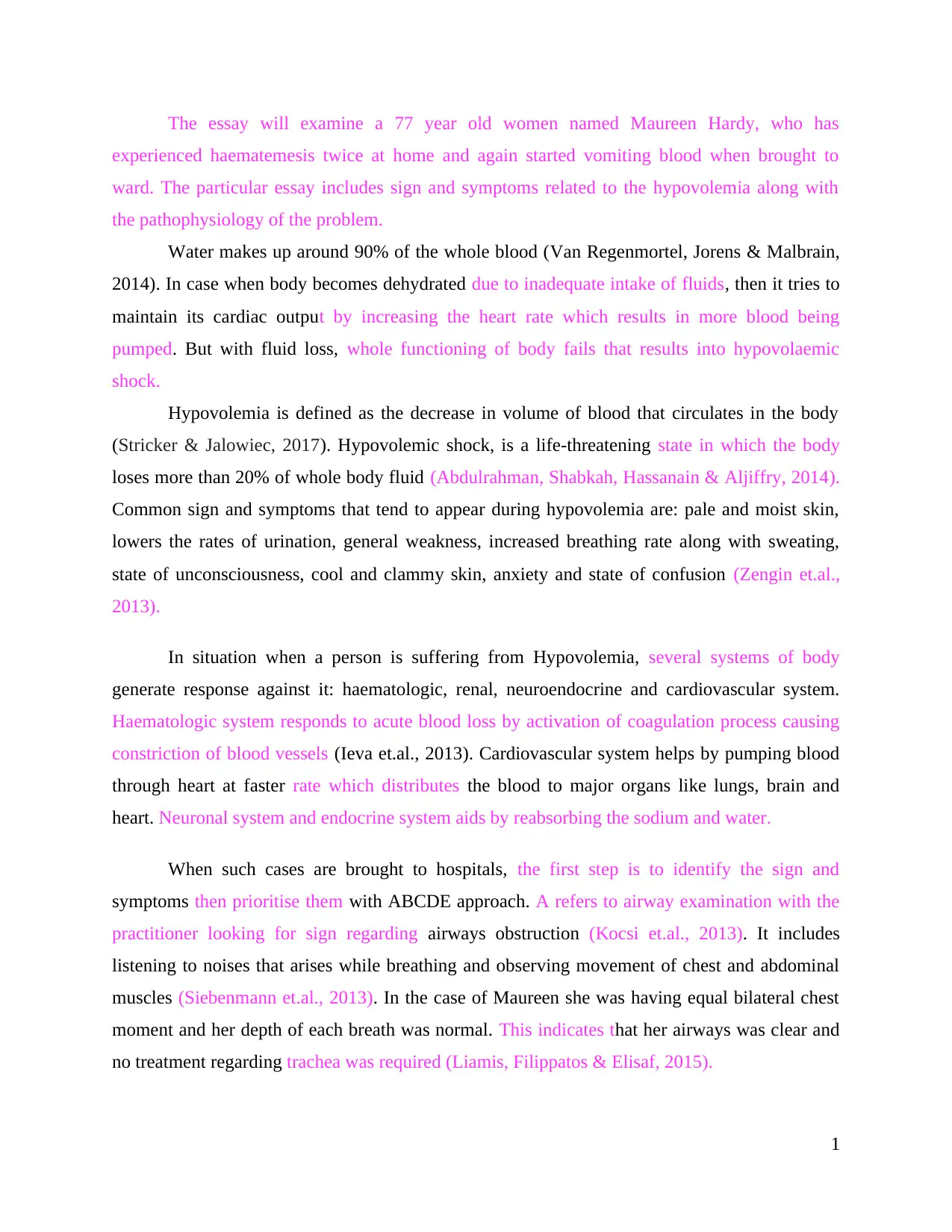
The essay will examine a 77 year old women named Maureen Hardy, who has
experienced haematemesis twice at home and again started vomiting blood when brought to
ward. The particular essay includes sign and symptoms related to the hypovolemia along with
the pathophysiology of the problem.
Water makes up around 90% of the whole blood (Van Regenmortel, Jorens & Malbrain,
2014). In case when body becomes dehydrated due to inadequate intake of fluids, then it tries to
maintain its cardiac output by increasing the heart rate which results in more blood being
pumped. But with fluid loss, whole functioning of body fails that results into hypovolaemic
shock.
Hypovolemia is defined as the decrease in volume of blood that circulates in the body
(Stricker & Jalowiec, 2017). Hypovolemic shock, is a life-threatening state in which the body
loses more than 20% of whole body fluid (Abdulrahman, Shabkah, Hassanain & Aljiffry, 2014).
Common sign and symptoms that tend to appear during hypovolemia are: pale and moist skin,
lowers the rates of urination, general weakness, increased breathing rate along with sweating,
state of unconsciousness, cool and clammy skin, anxiety and state of confusion (Zengin et.al.,
2013).
In situation when a person is suffering from Hypovolemia, several systems of body
generate response against it: haematologic, renal, neuroendocrine and cardiovascular system.
Haematologic system responds to acute blood loss by activation of coagulation process causing
constriction of blood vessels (Ieva et.al., 2013). Cardiovascular system helps by pumping blood
through heart at faster rate which distributes the blood to major organs like lungs, brain and
heart. Neuronal system and endocrine system aids by reabsorbing the sodium and water.
When such cases are brought to hospitals, the first step is to identify the sign and
symptoms then prioritise them with ABCDE approach. A refers to airway examination with the
practitioner looking for sign regarding airways obstruction (Kocsi et.al., 2013). It includes
listening to noises that arises while breathing and observing movement of chest and abdominal
muscles (Siebenmann et.al., 2013). In the case of Maureen she was having equal bilateral chest
moment and her depth of each breath was normal. This indicates that her airways was clear and
no treatment regarding trachea was required (Liamis, Filippatos & Elisaf, 2015).
1
experienced haematemesis twice at home and again started vomiting blood when brought to
ward. The particular essay includes sign and symptoms related to the hypovolemia along with
the pathophysiology of the problem.
Water makes up around 90% of the whole blood (Van Regenmortel, Jorens & Malbrain,
2014). In case when body becomes dehydrated due to inadequate intake of fluids, then it tries to
maintain its cardiac output by increasing the heart rate which results in more blood being
pumped. But with fluid loss, whole functioning of body fails that results into hypovolaemic
shock.
Hypovolemia is defined as the decrease in volume of blood that circulates in the body
(Stricker & Jalowiec, 2017). Hypovolemic shock, is a life-threatening state in which the body
loses more than 20% of whole body fluid (Abdulrahman, Shabkah, Hassanain & Aljiffry, 2014).
Common sign and symptoms that tend to appear during hypovolemia are: pale and moist skin,
lowers the rates of urination, general weakness, increased breathing rate along with sweating,
state of unconsciousness, cool and clammy skin, anxiety and state of confusion (Zengin et.al.,
2013).
In situation when a person is suffering from Hypovolemia, several systems of body
generate response against it: haematologic, renal, neuroendocrine and cardiovascular system.
Haematologic system responds to acute blood loss by activation of coagulation process causing
constriction of blood vessels (Ieva et.al., 2013). Cardiovascular system helps by pumping blood
through heart at faster rate which distributes the blood to major organs like lungs, brain and
heart. Neuronal system and endocrine system aids by reabsorbing the sodium and water.
When such cases are brought to hospitals, the first step is to identify the sign and
symptoms then prioritise them with ABCDE approach. A refers to airway examination with the
practitioner looking for sign regarding airways obstruction (Kocsi et.al., 2013). It includes
listening to noises that arises while breathing and observing movement of chest and abdominal
muscles (Siebenmann et.al., 2013). In the case of Maureen she was having equal bilateral chest
moment and her depth of each breath was normal. This indicates that her airways was clear and
no treatment regarding trachea was required (Liamis, Filippatos & Elisaf, 2015).
1

The second step of ABCDE approach refers to the breathing examination. In this type of
assessment doctors look for common sign for respiratory disorder like dyspnea, tachypnea and
abdominal breathing (Holder, Clermont & Pinsky, 2014). It also includes examining respiratory
rate, SaO2 reading, listening to breathing sound and examining the chest disorders (Phillip &
Runyon, 2014).
The breathing rate found in Maureen was 28 breaths per minute. This indicates that
Maureen was in the third stage of Hypovolemia, in this stage the breathing rate are above 20 and
below 30 breaths per minutes (Siebenmann et.al., 2013). It is also found that SaO2 is not
readable and it is necessary to identify to check the amount of oxygen content in blood (Zengin
et.al., 2013).
Next step regarding ABCDE approach is Circulation examination. According to this
examination, nurses will look at the colour of hand and face, temperature of body, they also
measure the capillary return time, check patient pulse rate and blood pressure and examine the
patient's whole body for any sign of haemorrhage and signs related to cardiac output (Vaughan &
Parry, 2016). In case of Maureen the blood pressure found was 80 mm Hg systolic, that indicates
the third stage of hypovolemia shock and needs an urgent treatment. The capillary refill time was
found less than 4 seconds which indicate the sign of dehydration and shock. The x-ray reports of
Maureen chest were normal no any disorder was found. Her temperature of 36.5 was found to be
normal. Dehydration is the main reason that she was looking sweaty and drowsy (Schulenkorf &
Spaaij, 2015). The Haemoglobin test of Maureen provided a reading of 9 g/dl, this indicates that
she is prone to anaemia and has lack of red blood cells in blood. Maureen was continuously
vomiting and her face was looking pale due to the loss of blood in her vomits. Haematocrit level
was 27% which also support the anaemic condition she has. These conditions needed to be
resolved early to reduce her other life-threatening risk.
In case of Maureen according to her ECG report, it was found that she was experiencing
Sinus tachycardia which indicates a heart rate greater than 100 beats per minute (Stricker &
Jalowiec, 2017). It was found that her heart rate was 120 beats per minute and was irregular, this
is because of the compensation of cardiovascular system (Hoiseth et.al., 2015). In case of
hypovolemia, the heart pumps more rapidly to distribute the blood to major organs including the
lungs, brain and heart. This resulted in the increased heart rate in Maureen.
2
assessment doctors look for common sign for respiratory disorder like dyspnea, tachypnea and
abdominal breathing (Holder, Clermont & Pinsky, 2014). It also includes examining respiratory
rate, SaO2 reading, listening to breathing sound and examining the chest disorders (Phillip &
Runyon, 2014).
The breathing rate found in Maureen was 28 breaths per minute. This indicates that
Maureen was in the third stage of Hypovolemia, in this stage the breathing rate are above 20 and
below 30 breaths per minutes (Siebenmann et.al., 2013). It is also found that SaO2 is not
readable and it is necessary to identify to check the amount of oxygen content in blood (Zengin
et.al., 2013).
Next step regarding ABCDE approach is Circulation examination. According to this
examination, nurses will look at the colour of hand and face, temperature of body, they also
measure the capillary return time, check patient pulse rate and blood pressure and examine the
patient's whole body for any sign of haemorrhage and signs related to cardiac output (Vaughan &
Parry, 2016). In case of Maureen the blood pressure found was 80 mm Hg systolic, that indicates
the third stage of hypovolemia shock and needs an urgent treatment. The capillary refill time was
found less than 4 seconds which indicate the sign of dehydration and shock. The x-ray reports of
Maureen chest were normal no any disorder was found. Her temperature of 36.5 was found to be
normal. Dehydration is the main reason that she was looking sweaty and drowsy (Schulenkorf &
Spaaij, 2015). The Haemoglobin test of Maureen provided a reading of 9 g/dl, this indicates that
she is prone to anaemia and has lack of red blood cells in blood. Maureen was continuously
vomiting and her face was looking pale due to the loss of blood in her vomits. Haematocrit level
was 27% which also support the anaemic condition she has. These conditions needed to be
resolved early to reduce her other life-threatening risk.
In case of Maureen according to her ECG report, it was found that she was experiencing
Sinus tachycardia which indicates a heart rate greater than 100 beats per minute (Stricker &
Jalowiec, 2017). It was found that her heart rate was 120 beats per minute and was irregular, this
is because of the compensation of cardiovascular system (Hoiseth et.al., 2015). In case of
hypovolemia, the heart pumps more rapidly to distribute the blood to major organs including the
lungs, brain and heart. This resulted in the increased heart rate in Maureen.
2
⊘ This is a preview!⊘
Do you want full access?
Subscribe today to unlock all pages.

Trusted by 1+ million students worldwide
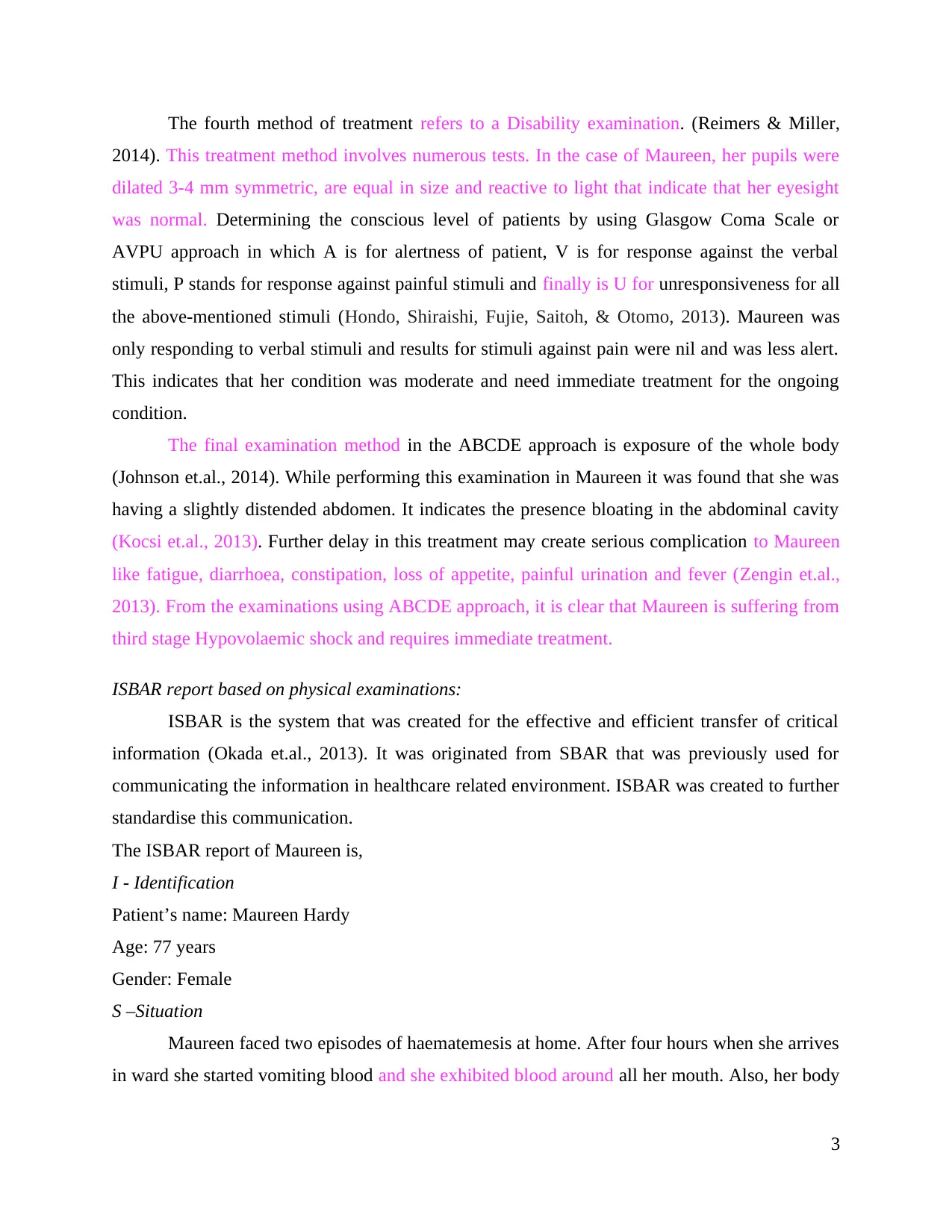
The fourth method of treatment refers to a Disability examination. (Reimers & Miller,
2014). This treatment method involves numerous tests. In the case of Maureen, her pupils were
dilated 3-4 mm symmetric, are equal in size and reactive to light that indicate that her eyesight
was normal. Determining the conscious level of patients by using Glasgow Coma Scale or
AVPU approach in which A is for alertness of patient, V is for response against the verbal
stimuli, P stands for response against painful stimuli and finally is U for unresponsiveness for all
the above-mentioned stimuli (Hondo, Shiraishi, Fujie, Saitoh, & Otomo, 2013). Maureen was
only responding to verbal stimuli and results for stimuli against pain were nil and was less alert.
This indicates that her condition was moderate and need immediate treatment for the ongoing
condition.
The final examination method in the ABCDE approach is exposure of the whole body
(Johnson et.al., 2014). While performing this examination in Maureen it was found that she was
having a slightly distended abdomen. It indicates the presence bloating in the abdominal cavity
(Kocsi et.al., 2013). Further delay in this treatment may create serious complication to Maureen
like fatigue, diarrhoea, constipation, loss of appetite, painful urination and fever (Zengin et.al.,
2013). From the examinations using ABCDE approach, it is clear that Maureen is suffering from
third stage Hypovolaemic shock and requires immediate treatment.
ISBAR report based on physical examinations:
ISBAR is the system that was created for the effective and efficient transfer of critical
information (Okada et.al., 2013). It was originated from SBAR that was previously used for
communicating the information in healthcare related environment. ISBAR was created to further
standardise this communication.
The ISBAR report of Maureen is,
I - Identification
Patient’s name: Maureen Hardy
Age: 77 years
Gender: Female
S –Situation
Maureen faced two episodes of haematemesis at home. After four hours when she arrives
in ward she started vomiting blood and she exhibited blood around all her mouth. Also, her body
3
2014). This treatment method involves numerous tests. In the case of Maureen, her pupils were
dilated 3-4 mm symmetric, are equal in size and reactive to light that indicate that her eyesight
was normal. Determining the conscious level of patients by using Glasgow Coma Scale or
AVPU approach in which A is for alertness of patient, V is for response against the verbal
stimuli, P stands for response against painful stimuli and finally is U for unresponsiveness for all
the above-mentioned stimuli (Hondo, Shiraishi, Fujie, Saitoh, & Otomo, 2013). Maureen was
only responding to verbal stimuli and results for stimuli against pain were nil and was less alert.
This indicates that her condition was moderate and need immediate treatment for the ongoing
condition.
The final examination method in the ABCDE approach is exposure of the whole body
(Johnson et.al., 2014). While performing this examination in Maureen it was found that she was
having a slightly distended abdomen. It indicates the presence bloating in the abdominal cavity
(Kocsi et.al., 2013). Further delay in this treatment may create serious complication to Maureen
like fatigue, diarrhoea, constipation, loss of appetite, painful urination and fever (Zengin et.al.,
2013). From the examinations using ABCDE approach, it is clear that Maureen is suffering from
third stage Hypovolaemic shock and requires immediate treatment.
ISBAR report based on physical examinations:
ISBAR is the system that was created for the effective and efficient transfer of critical
information (Okada et.al., 2013). It was originated from SBAR that was previously used for
communicating the information in healthcare related environment. ISBAR was created to further
standardise this communication.
The ISBAR report of Maureen is,
I - Identification
Patient’s name: Maureen Hardy
Age: 77 years
Gender: Female
S –Situation
Maureen faced two episodes of haematemesis at home. After four hours when she arrives
in ward she started vomiting blood and she exhibited blood around all her mouth. Also, her body
3
Paraphrase This Document
Need a fresh take? Get an instant paraphrase of this document with our AI Paraphraser
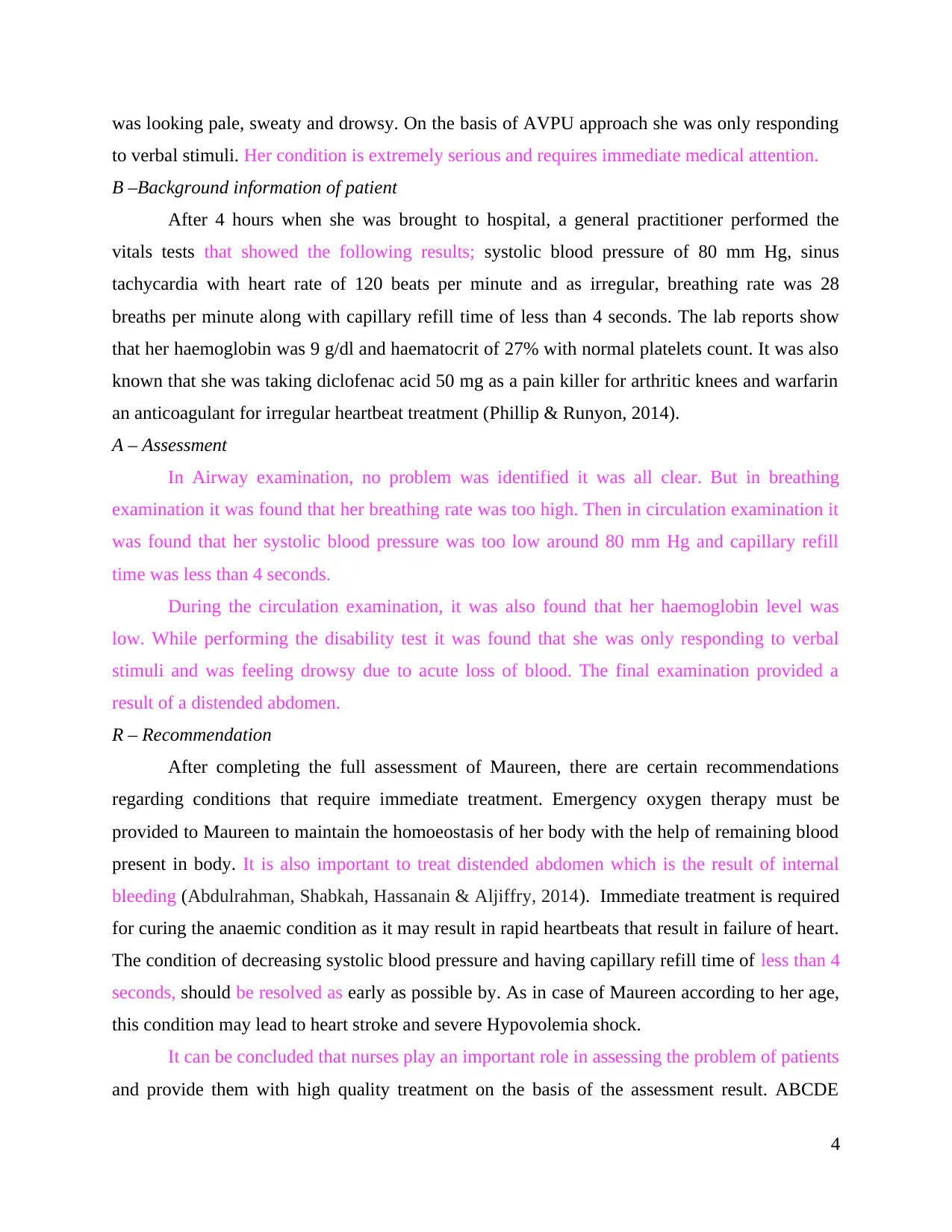
was looking pale, sweaty and drowsy. On the basis of AVPU approach she was only responding
to verbal stimuli. Her condition is extremely serious and requires immediate medical attention.
B –Background information of patient
After 4 hours when she was brought to hospital, a general practitioner performed the
vitals tests that showed the following results; systolic blood pressure of 80 mm Hg, sinus
tachycardia with heart rate of 120 beats per minute and as irregular, breathing rate was 28
breaths per minute along with capillary refill time of less than 4 seconds. The lab reports show
that her haemoglobin was 9 g/dl and haematocrit of 27% with normal platelets count. It was also
known that she was taking diclofenac acid 50 mg as a pain killer for arthritic knees and warfarin
an anticoagulant for irregular heartbeat treatment (Phillip & Runyon, 2014).
A – Assessment
In Airway examination, no problem was identified it was all clear. But in breathing
examination it was found that her breathing rate was too high. Then in circulation examination it
was found that her systolic blood pressure was too low around 80 mm Hg and capillary refill
time was less than 4 seconds.
During the circulation examination, it was also found that her haemoglobin level was
low. While performing the disability test it was found that she was only responding to verbal
stimuli and was feeling drowsy due to acute loss of blood. The final examination provided a
result of a distended abdomen.
R – Recommendation
After completing the full assessment of Maureen, there are certain recommendations
regarding conditions that require immediate treatment. Emergency oxygen therapy must be
provided to Maureen to maintain the homoeostasis of her body with the help of remaining blood
present in body. It is also important to treat distended abdomen which is the result of internal
bleeding (Abdulrahman, Shabkah, Hassanain & Aljiffry, 2014). Immediate treatment is required
for curing the anaemic condition as it may result in rapid heartbeats that result in failure of heart.
The condition of decreasing systolic blood pressure and having capillary refill time of less than 4
seconds, should be resolved as early as possible by. As in case of Maureen according to her age,
this condition may lead to heart stroke and severe Hypovolemia shock.
It can be concluded that nurses play an important role in assessing the problem of patients
and provide them with high quality treatment on the basis of the assessment result. ABCDE
4
to verbal stimuli. Her condition is extremely serious and requires immediate medical attention.
B –Background information of patient
After 4 hours when she was brought to hospital, a general practitioner performed the
vitals tests that showed the following results; systolic blood pressure of 80 mm Hg, sinus
tachycardia with heart rate of 120 beats per minute and as irregular, breathing rate was 28
breaths per minute along with capillary refill time of less than 4 seconds. The lab reports show
that her haemoglobin was 9 g/dl and haematocrit of 27% with normal platelets count. It was also
known that she was taking diclofenac acid 50 mg as a pain killer for arthritic knees and warfarin
an anticoagulant for irregular heartbeat treatment (Phillip & Runyon, 2014).
A – Assessment
In Airway examination, no problem was identified it was all clear. But in breathing
examination it was found that her breathing rate was too high. Then in circulation examination it
was found that her systolic blood pressure was too low around 80 mm Hg and capillary refill
time was less than 4 seconds.
During the circulation examination, it was also found that her haemoglobin level was
low. While performing the disability test it was found that she was only responding to verbal
stimuli and was feeling drowsy due to acute loss of blood. The final examination provided a
result of a distended abdomen.
R – Recommendation
After completing the full assessment of Maureen, there are certain recommendations
regarding conditions that require immediate treatment. Emergency oxygen therapy must be
provided to Maureen to maintain the homoeostasis of her body with the help of remaining blood
present in body. It is also important to treat distended abdomen which is the result of internal
bleeding (Abdulrahman, Shabkah, Hassanain & Aljiffry, 2014). Immediate treatment is required
for curing the anaemic condition as it may result in rapid heartbeats that result in failure of heart.
The condition of decreasing systolic blood pressure and having capillary refill time of less than 4
seconds, should be resolved as early as possible by. As in case of Maureen according to her age,
this condition may lead to heart stroke and severe Hypovolemia shock.
It can be concluded that nurses play an important role in assessing the problem of patients
and provide them with high quality treatment on the basis of the assessment result. ABCDE
4

approach is the best available technique to determine a patient’s condition. It aids the nurses and
practitioners by providing information regarding the condition that require immediate treatment
(Saeng-anan, Sreshthaputra, Sukpan, & Tongsong, 2013). It can also be inferred that ISBAR is a
helpful and effective system that helps in providing a successful transfer of patient’s information
in secure and protective way.
5
practitioners by providing information regarding the condition that require immediate treatment
(Saeng-anan, Sreshthaputra, Sukpan, & Tongsong, 2013). It can also be inferred that ISBAR is a
helpful and effective system that helps in providing a successful transfer of patient’s information
in secure and protective way.
5
⊘ This is a preview!⊘
Do you want full access?
Subscribe today to unlock all pages.

Trusted by 1+ million students worldwide
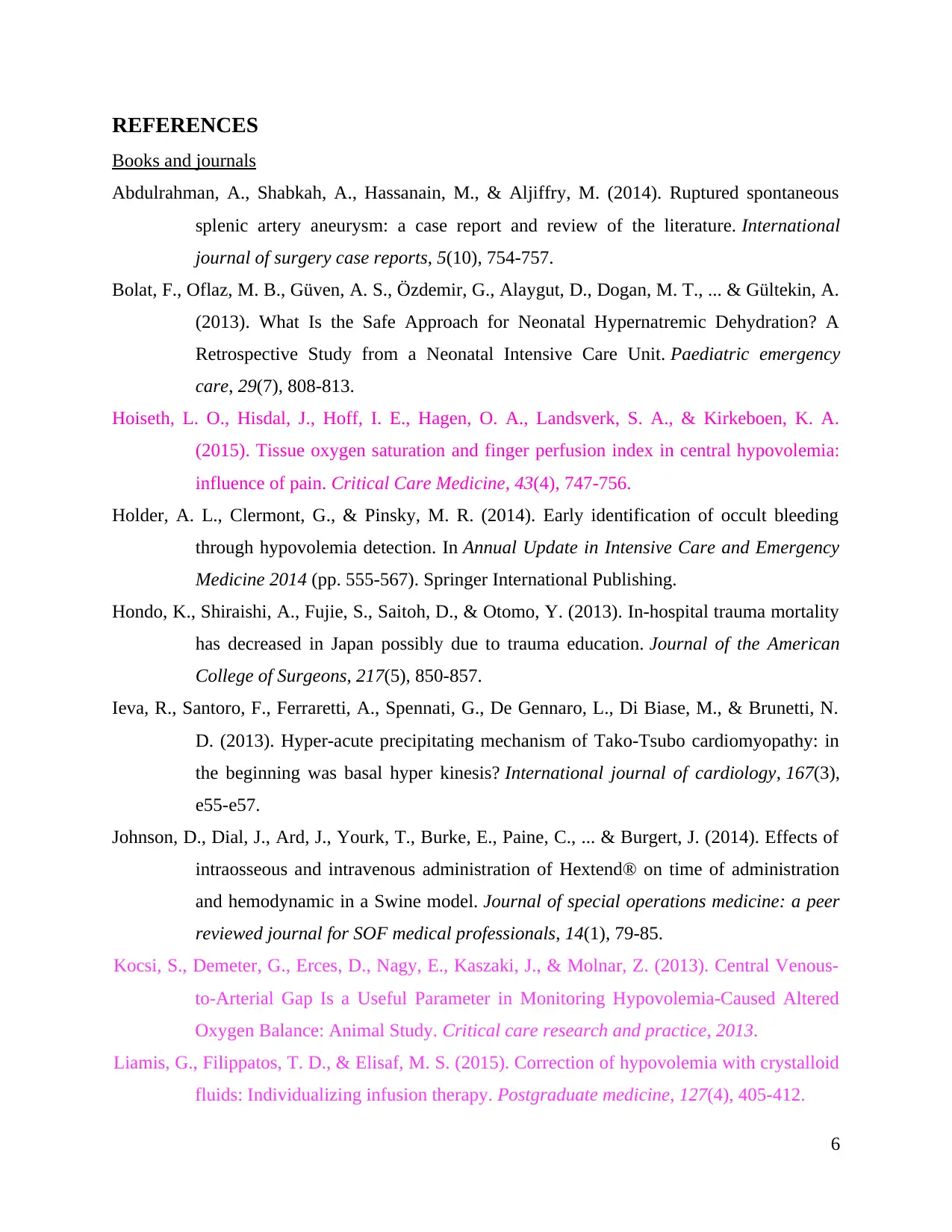
REFERENCES
Books and journals
Abdulrahman, A., Shabkah, A., Hassanain, M., & Aljiffry, M. (2014). Ruptured spontaneous
splenic artery aneurysm: a case report and review of the literature. International
journal of surgery case reports, 5(10), 754-757.
Bolat, F., Oflaz, M. B., Güven, A. S., Özdemir, G., Alaygut, D., Dogan, M. T., ... & Gültekin, A.
(2013). What Is the Safe Approach for Neonatal Hypernatremic Dehydration? A
Retrospective Study from a Neonatal Intensive Care Unit. Paediatric emergency
care, 29(7), 808-813.
Hoiseth, L. O., Hisdal, J., Hoff, I. E., Hagen, O. A., Landsverk, S. A., & Kirkeboen, K. A.
(2015). Tissue oxygen saturation and finger perfusion index in central hypovolemia:
influence of pain. Critical Care Medicine, 43(4), 747-756.
Holder, A. L., Clermont, G., & Pinsky, M. R. (2014). Early identification of occult bleeding
through hypovolemia detection. In Annual Update in Intensive Care and Emergency
Medicine 2014 (pp. 555-567). Springer International Publishing.
Hondo, K., Shiraishi, A., Fujie, S., Saitoh, D., & Otomo, Y. (2013). In-hospital trauma mortality
has decreased in Japan possibly due to trauma education. Journal of the American
College of Surgeons, 217(5), 850-857.
Ieva, R., Santoro, F., Ferraretti, A., Spennati, G., De Gennaro, L., Di Biase, M., & Brunetti, N.
D. (2013). Hyper-acute precipitating mechanism of Tako-Tsubo cardiomyopathy: in
the beginning was basal hyper kinesis? International journal of cardiology, 167(3),
e55-e57.
Johnson, D., Dial, J., Ard, J., Yourk, T., Burke, E., Paine, C., ... & Burgert, J. (2014). Effects of
intraosseous and intravenous administration of Hextend® on time of administration
and hemodynamic in a Swine model. Journal of special operations medicine: a peer
reviewed journal for SOF medical professionals, 14(1), 79-85.
Kocsi, S., Demeter, G., Erces, D., Nagy, E., Kaszaki, J., & Molnar, Z. (2013). Central Venous-
to-Arterial Gap Is a Useful Parameter in Monitoring Hypovolemia-Caused Altered
Oxygen Balance: Animal Study. Critical care research and practice, 2013.
Liamis, G., Filippatos, T. D., & Elisaf, M. S. (2015). Correction of hypovolemia with crystalloid
fluids: Individualizing infusion therapy. Postgraduate medicine, 127(4), 405-412.
6
Books and journals
Abdulrahman, A., Shabkah, A., Hassanain, M., & Aljiffry, M. (2014). Ruptured spontaneous
splenic artery aneurysm: a case report and review of the literature. International
journal of surgery case reports, 5(10), 754-757.
Bolat, F., Oflaz, M. B., Güven, A. S., Özdemir, G., Alaygut, D., Dogan, M. T., ... & Gültekin, A.
(2013). What Is the Safe Approach for Neonatal Hypernatremic Dehydration? A
Retrospective Study from a Neonatal Intensive Care Unit. Paediatric emergency
care, 29(7), 808-813.
Hoiseth, L. O., Hisdal, J., Hoff, I. E., Hagen, O. A., Landsverk, S. A., & Kirkeboen, K. A.
(2015). Tissue oxygen saturation and finger perfusion index in central hypovolemia:
influence of pain. Critical Care Medicine, 43(4), 747-756.
Holder, A. L., Clermont, G., & Pinsky, M. R. (2014). Early identification of occult bleeding
through hypovolemia detection. In Annual Update in Intensive Care and Emergency
Medicine 2014 (pp. 555-567). Springer International Publishing.
Hondo, K., Shiraishi, A., Fujie, S., Saitoh, D., & Otomo, Y. (2013). In-hospital trauma mortality
has decreased in Japan possibly due to trauma education. Journal of the American
College of Surgeons, 217(5), 850-857.
Ieva, R., Santoro, F., Ferraretti, A., Spennati, G., De Gennaro, L., Di Biase, M., & Brunetti, N.
D. (2013). Hyper-acute precipitating mechanism of Tako-Tsubo cardiomyopathy: in
the beginning was basal hyper kinesis? International journal of cardiology, 167(3),
e55-e57.
Johnson, D., Dial, J., Ard, J., Yourk, T., Burke, E., Paine, C., ... & Burgert, J. (2014). Effects of
intraosseous and intravenous administration of Hextend® on time of administration
and hemodynamic in a Swine model. Journal of special operations medicine: a peer
reviewed journal for SOF medical professionals, 14(1), 79-85.
Kocsi, S., Demeter, G., Erces, D., Nagy, E., Kaszaki, J., & Molnar, Z. (2013). Central Venous-
to-Arterial Gap Is a Useful Parameter in Monitoring Hypovolemia-Caused Altered
Oxygen Balance: Animal Study. Critical care research and practice, 2013.
Liamis, G., Filippatos, T. D., & Elisaf, M. S. (2015). Correction of hypovolemia with crystalloid
fluids: Individualizing infusion therapy. Postgraduate medicine, 127(4), 405-412.
6
Paraphrase This Document
Need a fresh take? Get an instant paraphrase of this document with our AI Paraphraser
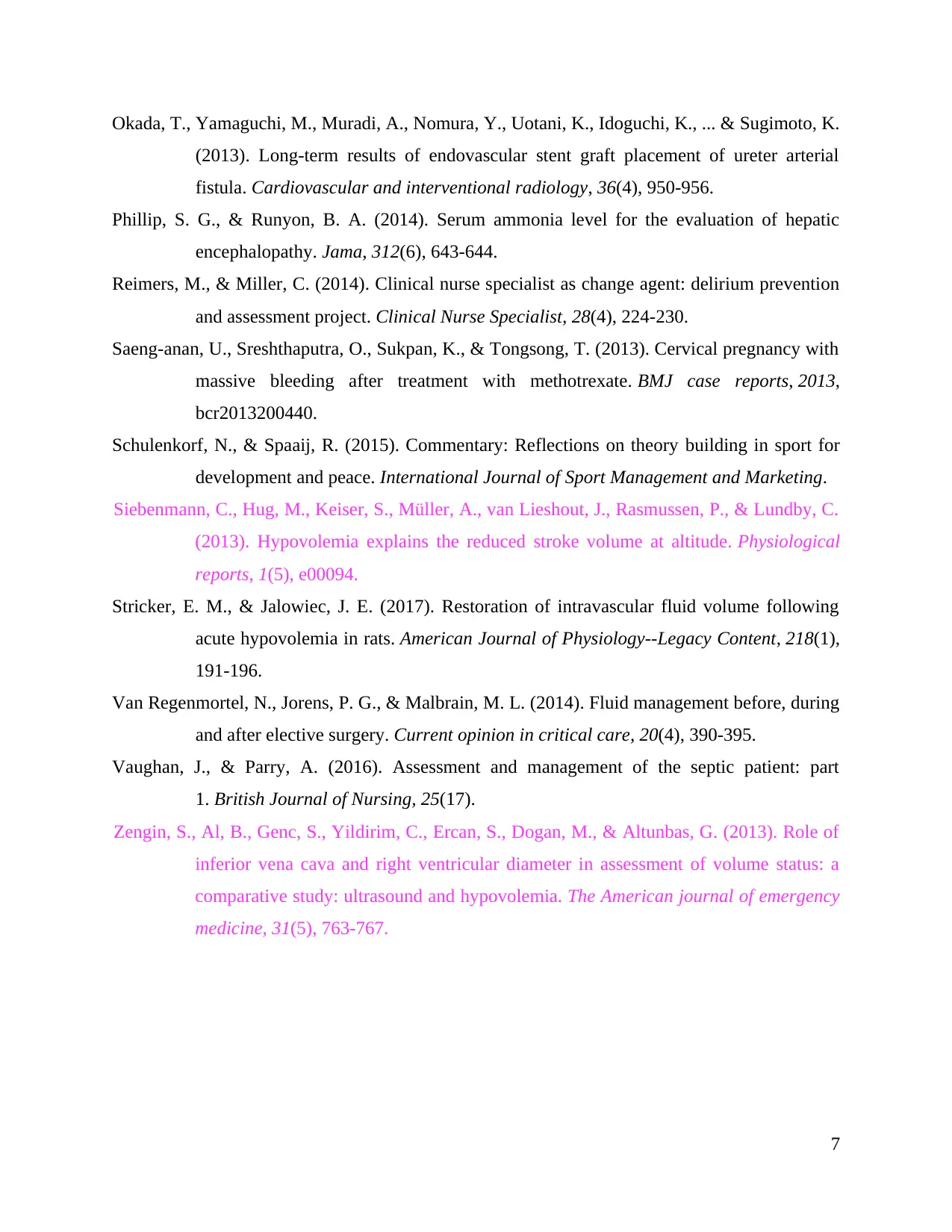
Okada, T., Yamaguchi, M., Muradi, A., Nomura, Y., Uotani, K., Idoguchi, K., ... & Sugimoto, K.
(2013). Long-term results of endovascular stent graft placement of ureter arterial
fistula. Cardiovascular and interventional radiology, 36(4), 950-956.
Phillip, S. G., & Runyon, B. A. (2014). Serum ammonia level for the evaluation of hepatic
encephalopathy. Jama, 312(6), 643-644.
Reimers, M., & Miller, C. (2014). Clinical nurse specialist as change agent: delirium prevention
and assessment project. Clinical Nurse Specialist, 28(4), 224-230.
Saeng-anan, U., Sreshthaputra, O., Sukpan, K., & Tongsong, T. (2013). Cervical pregnancy with
massive bleeding after treatment with methotrexate. BMJ case reports, 2013,
bcr2013200440.
Schulenkorf, N., & Spaaij, R. (2015). Commentary: Reflections on theory building in sport for
development and peace. International Journal of Sport Management and Marketing.
Siebenmann, C., Hug, M., Keiser, S., Müller, A., van Lieshout, J., Rasmussen, P., & Lundby, C.
(2013). Hypovolemia explains the reduced stroke volume at altitude. Physiological
reports, 1(5), e00094.
Stricker, E. M., & Jalowiec, J. E. (2017). Restoration of intravascular fluid volume following
acute hypovolemia in rats. American Journal of Physiology--Legacy Content, 218(1),
191-196.
Van Regenmortel, N., Jorens, P. G., & Malbrain, M. L. (2014). Fluid management before, during
and after elective surgery. Current opinion in critical care, 20(4), 390-395.
Vaughan, J., & Parry, A. (2016). Assessment and management of the septic patient: part
1. British Journal of Nursing, 25(17).
Zengin, S., Al, B., Genc, S., Yildirim, C., Ercan, S., Dogan, M., & Altunbas, G. (2013). Role of
inferior vena cava and right ventricular diameter in assessment of volume status: a
comparative study: ultrasound and hypovolemia. The American journal of emergency
medicine, 31(5), 763-767.
7
(2013). Long-term results of endovascular stent graft placement of ureter arterial
fistula. Cardiovascular and interventional radiology, 36(4), 950-956.
Phillip, S. G., & Runyon, B. A. (2014). Serum ammonia level for the evaluation of hepatic
encephalopathy. Jama, 312(6), 643-644.
Reimers, M., & Miller, C. (2014). Clinical nurse specialist as change agent: delirium prevention
and assessment project. Clinical Nurse Specialist, 28(4), 224-230.
Saeng-anan, U., Sreshthaputra, O., Sukpan, K., & Tongsong, T. (2013). Cervical pregnancy with
massive bleeding after treatment with methotrexate. BMJ case reports, 2013,
bcr2013200440.
Schulenkorf, N., & Spaaij, R. (2015). Commentary: Reflections on theory building in sport for
development and peace. International Journal of Sport Management and Marketing.
Siebenmann, C., Hug, M., Keiser, S., Müller, A., van Lieshout, J., Rasmussen, P., & Lundby, C.
(2013). Hypovolemia explains the reduced stroke volume at altitude. Physiological
reports, 1(5), e00094.
Stricker, E. M., & Jalowiec, J. E. (2017). Restoration of intravascular fluid volume following
acute hypovolemia in rats. American Journal of Physiology--Legacy Content, 218(1),
191-196.
Van Regenmortel, N., Jorens, P. G., & Malbrain, M. L. (2014). Fluid management before, during
and after elective surgery. Current opinion in critical care, 20(4), 390-395.
Vaughan, J., & Parry, A. (2016). Assessment and management of the septic patient: part
1. British Journal of Nursing, 25(17).
Zengin, S., Al, B., Genc, S., Yildirim, C., Ercan, S., Dogan, M., & Altunbas, G. (2013). Role of
inferior vena cava and right ventricular diameter in assessment of volume status: a
comparative study: ultrasound and hypovolemia. The American journal of emergency
medicine, 31(5), 763-767.
7
1 out of 8
Related Documents
Your All-in-One AI-Powered Toolkit for Academic Success.
+13062052269
info@desklib.com
Available 24*7 on WhatsApp / Email
![[object Object]](/_next/static/media/star-bottom.7253800d.svg)
Unlock your academic potential
Copyright © 2020–2025 A2Z Services. All Rights Reserved. Developed and managed by ZUCOL.





